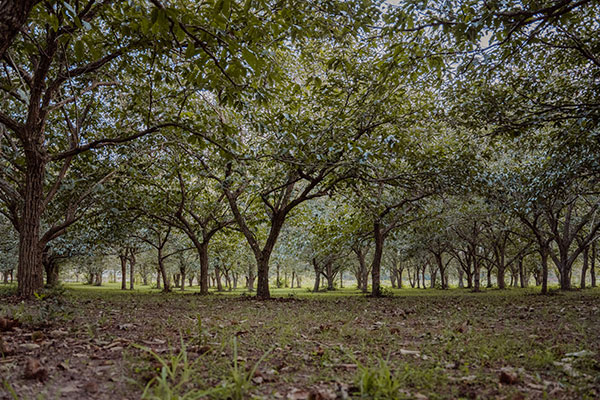Chestnuts vs Acorns

Over eons, nature has fine-tuned its annual cycles so that resources are most abundant at their greatest time of need. One example is hard masts, a critically important natural food source for wildlife like white-tailed deer, bears, squirrels, hogs, and more. Nuts ripen and drop in autumn. Just as these creatures build up energy and fat stores, they will need to survive the nutritional bottleneck of winter.
Research has shown that deer highly favor acorns, representing the most common and abundant type of hard mast. That was not always the case, however, at least in eastern North America. Before the early 1900s, American chestnuts (Castanea dentata) were the most prominent hard mast-producing trees, making up an estimated 25 percent of the eastern hardwood forest. In just three decades, the chestnut blight virtually wiped out chestnut trees. So, the strong preference for acorns shown by deer and other wildlife is not because they are the best but because they are the best food source available. Fortunately, efforts have been underway for some time now to restore the mast king, and with good reason. Simply stated, chestnuts are superior in several ways.
Nutrition
Nutritionally speaking, chestnuts are better than acorns. Hard mast is a crucial autumn food source for all types of wildlife, especially white-tailed deer. They need the carbohydrates for the energy they will burn during the rut, then later to lay on energy reserves they will use to withstand the winter. Chestnuts contain approximately 40 percent carbohydrates, compared to only about 10 percent for white oak acorns. Furthermore, mature chestnut trees can produce more carbohydrates per acre than corn. Other species, like bears, turkeys, squirrels and chipmunks, also seek food sources high in carbohydrates to build their energy reserves before retiring for the winter.
All these creatures also need protein, and the less energy expended to acquire it, the healthier they will be. Chestnuts contain 10 percent protein and 2 percent fat compared to only 4 percent protein in white oak acorns and 10 percent fat in acorns. The higher fat content gives acorns a slight advantage later on into winter, making them a seasonal dessert after a main course of chestnuts.
Like humans, deer also need vitamins and trace minerals, some of which are often lacking in some areas. Chestnuts contain more vitamins C, E and K and are higher in iron, potassium, calcium and selenium than acorns. While iron and potassium are often abundant in the environment, selenium is sometimes scarce, yet is essential for immune function, reproduction and overall health.
While they have been largely absent from the landscape for several centuries, deer still strongly prefer chestnuts when they can find them. Deer have more tastebuds than humans, making them more sensitive to tannins. Chestnuts are more palatable because they lack tannic acid, giving acorns a bitter taste. Red oak acorns contain more tannic acid than white oak acorns, so many deer tend to choose nuts with a sweeter taste. In studies of captive deer, Dr. James Kroll found deer preferred chestnuts to acorns at a rate of 100:1.

Growth and Production
Land stewards planning to plant mast orchards or food plots have plenty of options, but chestnut trees are better short and long-term investments than oaks because they grow faster and much larger. Given optimum conditions, chestnut trees may begin bearing nuts within 2-5 years. White oak trees might not bear for 20 years, and who wants to wait that long to see the fruits of their labor? Eventually, chestnut trees can grow 60-80 feet tall and become prolific hard mast producers. Dunstan Chestnut trees, for example, can annually produce up to 2,000 pounds of nuts per acre at maturity.
Consistency
Chestnut trees also have several growth characteristics that make them more reliable and consistent mast producers. First, they flower later in spring than oak trees. A later blooming time reduces the possibility of damage from occasional late frosts that could result in widespread acorn failures and starvation years for wildlife.
Second, they lack the cyclical nature of oaks and, under favorable conditions, will produce every year, unlike any other types of nuts. It takes red oak acorns two years to mature and drop. One poor growth year caused by a late frost, lack of moisture or other climatic anomalies could translate to at least three years of poor production. Even under the most inadequate conditions, chestnuts typically produce some nuts and can quickly rebound to produce a bumper crop by the following year. White oaks can also produce acorns yearly, but only if conditions are optimal, so they tend to alternate between years of good, bad, and sometimes no production.
A United States Forest Service study on the 12-year acorn yield of southern Appalachian oak trees found white oaks produced bumper crops only every four years and red oaks every five years, on average. Planting red and white oak trees, various types of nuts and persimmons can help fill some nutritional gaps, but not all.
The chestnut is the champion when providing hard mast options for wildlife, consistently producing more nutritious nuts. A more consistent source of high-quality food during periods of nutritional stress, like autumn and winter, reduces fluctuations in wildlife populations, meaning more and healthier animals on the landscape. As a bonus, their sweet, delectable flavor makes them prized by people, too, whether roasted on an open fire, stuffed into a Thanksgiving turkey, or ground into flour for cakes, breads, or pastries. Oaks are still popular and readily available, but if the plan is to plant mast-producing trees, put chestnuts at the top of the menu for local wildlife.


